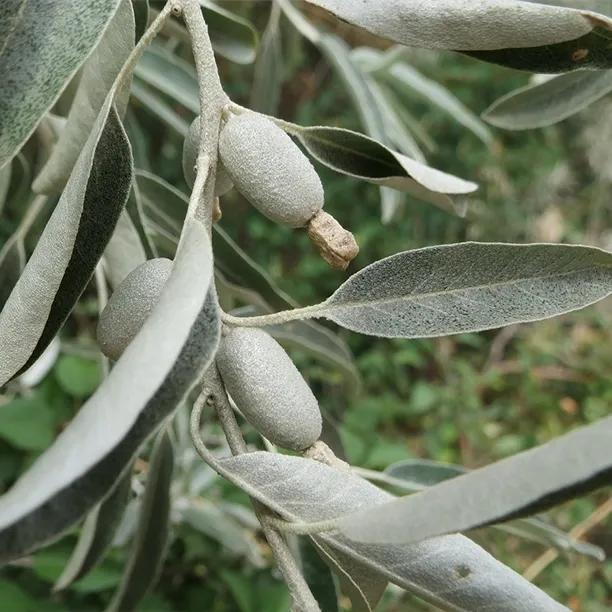Elaeagnus (Oleaster) Hedge Plants
Honest Delivery PricesElaeagnus angustifolia
Hedge Plants
- Thorny hedging shrub.
- Deciduous.
- Fixes nitrogen, ideal for the coast.
- Sizes: Saplings only.
- Max. Height: 4m
- Bareroot Delivery Only: Nov-Mar.
Recommended extras
Description
Elaeagnus Angustifolia Hedging
Delivered by Mail Order Direct from our Nursery with a Year Guarantee
Elaeagnus angustifolia, Oleaster, is a big deciduous thorny shrub that thrives in poor soil by the sea and is able to grow on almost pure sand.
Elaeagnus angustifolia is good for hedges up to about 4 metres high.
Elaeagnus angustifolia hedge plants are only delivered bareroot, during winter (Nov-March).
All our hedge plants are measured by their height in centimetres above the ground (the roots aren't measured).
Spacing an Elaeagnus angustifolia hedge:
Plant Elaeagnus angustifolia hedging at 3 plants per metre, 33cm apart.
General description of Elaeagnus angustifolia plants:
This is a hardy hedging plant for poor soils and windy sites on the coast. It is thorny and has silvery, fragrant foliage. The small, abundant yellow flowers aren't very showy, but they have a good scent that carries well. These mature into small silver-orange berries, which are edible, although they don't have much flavour and tend to be quickly picked off by birds. As a shrub, Oleaster is also good for small gardens. Oleaster's roots fix nitrogen, so it will thrive on the worst soils.
View our selection of coastal hedging plants or see our full range of hedging.
History & uses of Oleaster:
Common Names: Oleaster, Silver berry bush, Russian olive, Wild olive
Elaeagnus angustifolia's native range is from Russia to Iran, where its berries are dried, powdered and added to milk for drinking. It has been grown in Britain since the 1500s.
Planting Instructions
Growing Elaeagnus angustifolia plants:
Elaeagnus angustifolia will grow well in any sunny, well drained soil apart from shallow chalk, although it will tolerate most other alkaline soils. It is suitable for exposed, salty seaside areas and mature plants are very drought hardy.
Prepare your site before planting:
It is good to dig over the area where you plant a hedge several months in advance, especially if the soil is poor. Destroy the weeds first: nettles, brambles and ground elder are tough. Then dig the soil over; remove rocks, roots and other rubbish. Mix in well rotted compost or manure down to the depth of about 2 spades. If your soil is rich, you don't have to dig it over, but killing all the weeds is still necessary.
Watch our video on how to plant a country hedge for full details. The instruction to cut the plants in half after planting only applies to thorny native hedging and plants in the conservation hedge mix: this isn't necessary for Elaeagnus angustifolia.
Remember to water establishing plants during dry weather for at least a year after planting.
Hedge Planting Accessories:
Prepare your site for planting by killing the weeds and grass.
You can buy a hedge planting pack with sheets of mulch fabric and pegs to hold it down.
If you are planting in an area with rabbit and/or deer, you will need to use a plastic spiral guard for each plant, supported by a bamboo cane.
If your soil quality is poor, we recommend using mycorrhizal "friendly fungi" on the roots of new trees and shrubs.
You can also improve your soil with bonemeal organic fertiliser.
After Care
After you have planted your Elaeagnus angustifolia hedge, the most important thing to do is water it in dry weather. You will also need to weed around the plants. Watering should be thorough, so the ground is soaked. Let the soil almost dry out before watering again. Watering & weeding will be necessary for at least a year after planting.
Trimming Elaeagnus hedge plants:
Elaeagnus angustifolia doesn't need any clipping at all in its first year. In the winter of the year after planting, your young hedge should be trimmed lightly and every winter after that until it is mature.
When it is fully grown, you can clip it at anytime.
Special notes on caring for Elaeagnus angustifolia hedges:
Elaeagnus angustifolia is a very tough hedge plant that shouldn't need special attention once it has established. If you didn't use a mulch fabric, it is beneficial to mulch around the base of the hedge each year.
Hygiene & Diseases:
Dead, damaged or diseased wood can be pruned off as soon as it appears.
Disinfect your pruning tools between every cut if there is any sign of disease.
Burn or dispose of any diseased material, do not compost it.
After you have planted your Elaeagnus angustifolia hedge, the most important thing to do is water it in dry weather. You will also need to weed around the plants. Watering should be thorough, so the ground is soaked. Let the soil almost dry out before watering again. Watering & weeding will be necessary for at least a year after planting.
Trimming Elaeagnus hedge plants:
Elaeagnus angustifolia doesn't need any clipping at all in its first year. In the winter of the year after planting, your young hedge should be trimmed lightly and every winter after that until it is mature.
When it is fully grown, you can clip it at anytime.
Special notes on caring for Elaeagnus angustifolia hedges:
Elaeagnus angustifolia is a very tough hedge plant that shouldn't need special attention once it has established. If you didn't use a mulch fabric, it is beneficial to mulch around the base of the hedge each year.
Hygiene & Diseases:
Dead, damaged or diseased wood can be pruned off as soon as it appears.
Disinfect your pruning tools between every cut if there is any sign of disease.
Burn or dispose of any diseased material, do not compost it.


